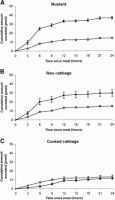L
lollipop
Guest
Nice post @TravisYes. I while back I looked up the goitrogenic effect of some vegetables. The main two goitrogens are the thiocyanate ion and goitrin.
The thiocyanate ion, not to be confused with isothiocyanates, competitively inhibits iodine binding in the thyroid. This is reversible and can be obviated by extra iodine. Everyone has a measurable level of thiocyate ion in their blood, even people that don't eat it. Thiocyanate can be produced endogenously by cyanide (smokers have higher levels). Thiocyanate ions can ultimately come from crucifers, turnips, horseradish, cassava, mustard, ect...
The more powerful goitrogen is 'goitrin'. This is a molecule formed from certain glycosides. There are thousands of glycosides (molecules bound to glucose) in foods, and only one of them seems to release goitrin; and is called progoitrin, or 2-hydroxy-3-butenyl glucosinolate.
It turns out that this compound is high is genus Brassica; species Rapa. This includes rapeseed (see canola oil), bok choy, mustard greens and Russian kale.
Genus Brassica; species oleracea, is low in progoitrin. This includes brocolli, curly kale, lacinato kale, cabbage, cauliflower, ect.
So make sure your Kale is not Russian Kale! Russian Kale has a purple stem! Stay away from Brassica Rapa.
And if you eat thiocyanate-containing vegetables, make sure you get enough iodide through seaweed or sea-animals.

